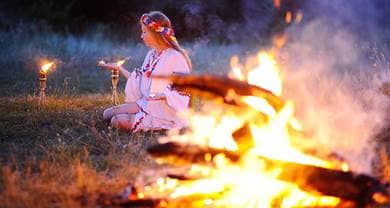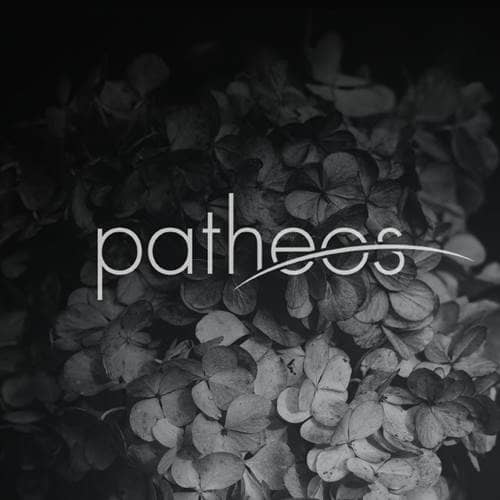- Trending:
- Forgiveness
- |
- Resurrection
- |
- Joy
- |
- Feminism
- |
- Afterlife

RELIGION LIBRARY
Paganism
Ethics and Community
Gender and Sexuality
When Gerald Gardner and his associates began publicly to discuss and promote Wicca in the 1950s and 1960s, several elements of the movement had strong erotic or fertility overtones. Gardner's group performed their rituals in the nude - a phenomenon called "working skyclad" - and one of the tools used in some rites was a scourge (which symbolized self-denial or sacrificial suffering). Some rites included ceremonial kissing between the priest and the priestess, while the dramatic "Great Rite" involved either actual or symbolic sexual intercourse between the priest and priestess leading the ritual.
Although Gardnerian Wicca may be extreme in its explicit use of erotic symbolism and rituals - other forms of Wicca, witchcraft, and other nature religions do not always work skyclad or engage in other forms of ceremonial sexual expression - it is emblematic of the unabashedly positive view that Paganism in general holds toward sexuality. Unlike other religious traditions that have advocated celibacy, prohibited all sexual expression outside of marriage, and encouraged married couples to limit or restrict their sexual behavior, Pagan religions often reflect the permissiveness of the 1960s-era sexual revolution in regard to extramarital sexuality, homosexuality, swinging or non-monogamous relationships, fetishes or BDSM, use of contraceptives, and abortion. Although many adherents of Paganism adopt lifestyles consistent with mainstream liberal society, those who choose alternative lifestyles generally are accepted within the Pagan community with no need to hide or apologize for their lifestyle choice.
Like society at large, Pagans abhor predatory or coercive sexual acts such as rape, date rape, child molestation, exploitative pornography, or sexual harassment. While polyamory (non-monogamy) and swinging is generally tolerated, opinion is divided among Pagans as to whether such behavior is truly good. Even those who accept or embrace non-monogamy believe it is wrong to lie or deceive one's partner(s) about such behavior - in other words, it is only okay to have multiple sexual partners when everyone involved is knowledgeable and accepting of the situation.
Although abortion is not considered immoral in the Pagan community, the use of contraceptives is seen as preferable to the emotional and physical trauma of abortion. Persons with sexually transmitted diseases have a moral obligation to either refrain from sexual activity or, at the least, inform partners of their situation and use condoms or other prophylactics to reduce the risk of transmission.
Along with the liberal and positive approach to sexual behavior and ethics, Paganism generally endorses feminism and accepts a post-patriarchal understanding of gender. Nearly all segments of the Pagan community regard men and women as true equals, complementary to the extent that the biological realities of gender means some differences in abilities and strengths, but with a clear understanding that this complementarity does not in any way privilege one gender over the other. While some groups (such as Dianic Witchcraft) may limit their membership to one gender and consequently may regard that gender as privileged in some ways, for the most part nature spiritualities exult in the differences between male and female and celebrate the joyful ways in which those differences can come together in friendship, love, and sexual union.
With this basic affirmation of equality between the sexes in place, the Pagan community nevertheless includes broad possibilities for the expression of gender identity. Traditional gender roles (such as the strong male warrior and the nurturing mother) are accepted and in some settings even affirmed. Some Pagan groups recognize a difference between "Male Mysteries" and "Female Mysteries" - male mysteries can include a celebration of hunting, athletic competition, the ethos of the warrior, and the cultivation of virtues such as bravery and honor; likewise, female mysteries can include the celebration of the menstrual cycle, the feminine journey from maiden to mother to crone, and the cultivation of traditionally "feminine" skills such as divination, herbalism, or healing work.
The concept of male and female mysteries, like the construction of gender identity itself, is fluid and can vary from group to group (or even individual to individual). And while some groups may enforce restrictions that only allow persons who are genetically male or female to participate in the mysteries of their gender, on a purely individual level much latitude exists within the larger Pagan community for men or women to pursue their own interests, regardless of traditional gender affiliation. Thus, male herbalists and female warriors are not only acceptable within the Pagan community, but can even be regarded as prestigious examples of the personal freedom available within the community.
Gay, lesbian, bisexual, intersexed, and transgendered persons also are generally welcomed within the Pagan community. Although some groups specifically cater to non-heterosexual or non-exclusively-heterosexual Pagans, many groups welcome diversity in sexual expression among their members. Those whose sexuality and gender identity differ from societal norms are a sign not only of the diversity of nature itself, but also the liberality and tolerance that most Pagans consider to be bedrock values of their spirituality.
Back to Religion Library
Although Gardnerian Wicca may be extreme in its explicit use of erotic symbolism and rituals - other forms of Wicca, witchcraft, and other nature religions do not always work skyclad or engage in other forms of ceremonial sexual expression - it is emblematic of the unabashedly positive view that Paganism in general holds toward sexuality. Unlike other religious traditions that have advocated celibacy, prohibited all sexual expression outside of marriage, and encouraged married couples to limit or restrict their sexual behavior, Pagan religions often reflect the permissiveness of the 1960s-era sexual revolution in regard to extramarital sexuality, homosexuality, swinging or non-monogamous relationships, fetishes or BDSM, use of contraceptives, and abortion. Although many adherents of Paganism adopt lifestyles consistent with mainstream liberal society, those who choose alternative lifestyles generally are accepted within the Pagan community with no need to hide or apologize for their lifestyle choice.
Like society at large, Pagans abhor predatory or coercive sexual acts such as rape, date rape, child molestation, exploitative pornography, or sexual harassment. While polyamory (non-monogamy) and swinging is generally tolerated, opinion is divided among Pagans as to whether such behavior is truly good. Even those who accept or embrace non-monogamy believe it is wrong to lie or deceive one's partner(s) about such behavior - in other words, it is only okay to have multiple sexual partners when everyone involved is knowledgeable and accepting of the situation.
Although abortion is not considered immoral in the Pagan community, the use of contraceptives is seen as preferable to the emotional and physical trauma of abortion. Persons with sexually transmitted diseases have a moral obligation to either refrain from sexual activity or, at the least, inform partners of their situation and use condoms or other prophylactics to reduce the risk of transmission.
Along with the liberal and positive approach to sexual behavior and ethics, Paganism generally endorses feminism and accepts a post-patriarchal understanding of gender. Nearly all segments of the Pagan community regard men and women as true equals, complementary to the extent that the biological realities of gender means some differences in abilities and strengths, but with a clear understanding that this complementarity does not in any way privilege one gender over the other. While some groups (such as Dianic Witchcraft) may limit their membership to one gender and consequently may regard that gender as privileged in some ways, for the most part nature spiritualities exult in the differences between male and female and celebrate the joyful ways in which those differences can come together in friendship, love, and sexual union.
With this basic affirmation of equality between the sexes in place, the Pagan community nevertheless includes broad possibilities for the expression of gender identity. Traditional gender roles (such as the strong male warrior and the nurturing mother) are accepted and in some settings even affirmed. Some Pagan groups recognize a difference between "Male Mysteries" and "Female Mysteries" - male mysteries can include a celebration of hunting, athletic competition, the ethos of the warrior, and the cultivation of virtues such as bravery and honor; likewise, female mysteries can include the celebration of the menstrual cycle, the feminine journey from maiden to mother to crone, and the cultivation of traditionally "feminine" skills such as divination, herbalism, or healing work.
The concept of male and female mysteries, like the construction of gender identity itself, is fluid and can vary from group to group (or even individual to individual). And while some groups may enforce restrictions that only allow persons who are genetically male or female to participate in the mysteries of their gender, on a purely individual level much latitude exists within the larger Pagan community for men or women to pursue their own interests, regardless of traditional gender affiliation. Thus, male herbalists and female warriors are not only acceptable within the Pagan community, but can even be regarded as prestigious examples of the personal freedom available within the community.
Gay, lesbian, bisexual, intersexed, and transgendered persons also are generally welcomed within the Pagan community. Although some groups specifically cater to non-heterosexual or non-exclusively-heterosexual Pagans, many groups welcome diversity in sexual expression among their members. Those whose sexuality and gender identity differ from societal norms are a sign not only of the diversity of nature itself, but also the liberality and tolerance that most Pagans consider to be bedrock values of their spirituality.
Study Questions:
1. Where can erotic and fertility undertones be seen within the Pagan tradition?
2. How is sexuality viewed? Why?
3. What is the relationship between Paganism and feminism?
4. Do Pagans hold to traditional gender roles? Why or why not?
Editor's picks See all columnists










